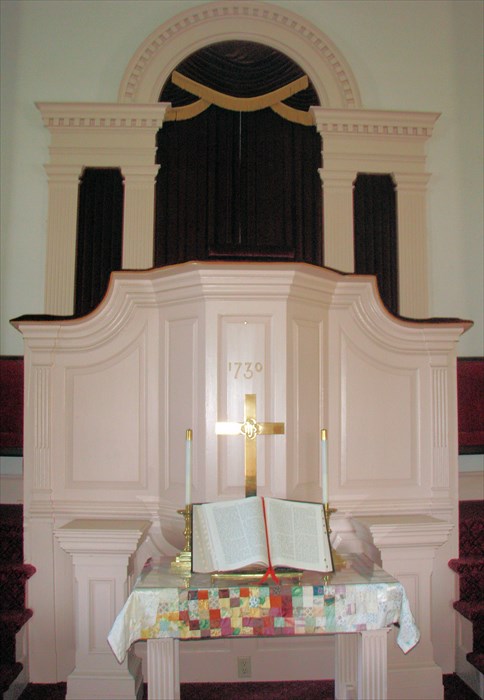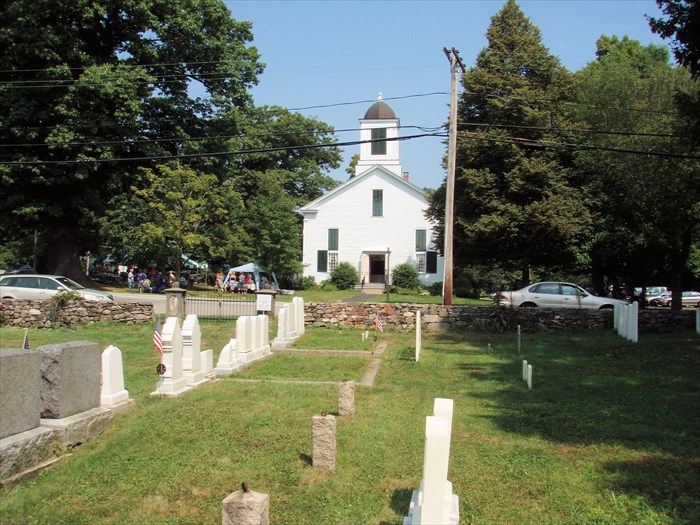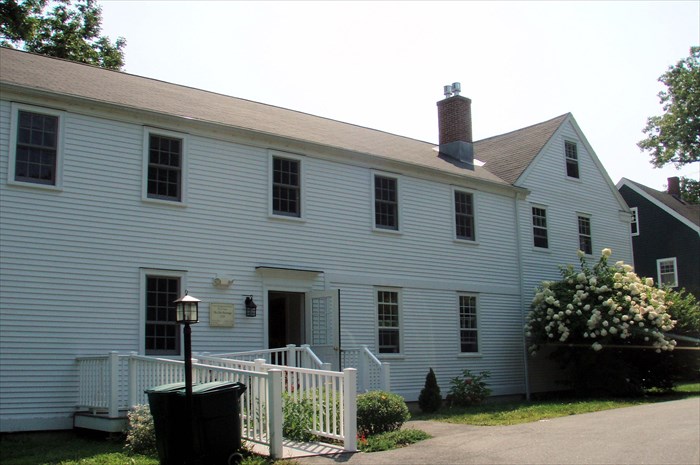This church building and the accompanying parsonage have be well maintained over the years, and are landmark on this corner. Across from the church is the historic Lady Pepperrell House, on the other corner is a cemetery with many old graves, including those of Armercian Revolutionary veterans, and
General William Whipple, signer of the Declaration of Independence who was born near here. His Father, Captain William F. Whipple was an early benefactor of the church, and had his son christened here.

Here is a short excerpt from the
First Congregational Church website:
"Our church is the oldest church building in continuous use in the state of Maine. Built in 1730, the church maintains a number of original features -- including the original 1730 pulpit, and the original two-aisle design common in New England meetinghouses."
Because of the scarcity of historical material online, here is an excerpt from a book by Everett S. Stackpole, published in 1903 by the Press of Lewiston Journal Company entitled, Old Kittery and Her Families
First a brief statement about the Colonial Day Celebration at the church:
"The two-century-old church was nearly filled to capacity as the service in memory of Capt. William F. Whipple and his son, Gen. William Whipple, who was born in the Whipple Garrison house in Kittery in 1 June 1730, and later one of the signers of the Declaration of Independence.
Captain Whipple donated the first piece of communion silver, a cup, to the church in 1728.
General Whipple was christened,in front of the church pulpit Feb. 14,1731" [see also photo gallery]
While it is clear that there were worship services held in this are for many years, there had never been a settled minister or a permanent building, and the town seems to have suffered from it. Stackpole gives the following account:
"6 July 1675, the Selectmen of Kittery were presented at Court "for not taking care that their children and youth be taught the catechism," and 2 July 1679 the lower end of Kittery was indicted for not getting a minister. The next minister we read of in Kittery was Benjamin Woodbridge,in 1688-9. He was son of Rev. John Woodbridge of Andover, Mass., born about 1647, and died in Medford, Mass., 15 Jan. 1710.

In February, 1693-4, it was voted that the minister should have "five & fortie pounds per annum in money and Suitable acommodation for diet." Fifteen pounds a year were allowed for his board. A meeting of the lower division of Kittery was called, 13 May 1695, "in order to ye continuance of Mr. John Newmarch in said Town. This is the first mention of the first ordained minister of Kittery, who filled the pulpit at Kittery Point for over half a century. He preached on alternate Sabbaths, during his early ministry, at the house of Capt. William Fernald and at Long Reach. He also taught school for many years. He was not ordained as pastor till Nov. 4, 1714, and then a Congregational church was organized with eighteen male and twenty-five female members. Mr. Newmarch graduated at Harvard in 1690. His ministry was a fruitful one. Both in the church and in the school he was the educator of the people of Kittery.
His grave, in a clump of bushes near where he lived, was marked only a few years ago by a marble slab with appropriate inscription. This slab has recentlv fallen and is broken. The citizens of Kitterv owe too much to this man to allow his grave to be uncared for. So many ancestors who slumber about him with unmarked graves deserve, too, a properly fenced and honored burial-place.

PARSONAGE AT KITTERY POINT, BUILT 1729.
The salary of Mr. Newmarch was eighty-five pounds for the first year and one hundred pounds for every year after. There was from time to time a nominal increase of salary necessitated by the depreciation of currency. In addition he had the use of the ministry lands at Pine Point, on the east side of Spruce Creek, which lie had liberty to rent for periods of seven years. In 1729 a parsonage was built near the church at the Point. It was forty foot by nineteen and two stories high. In 1733 the parish voted to dig a well on the parsonage land and to fence the burial place with a stone wall. In 1714 a bell was procured, for which Capt. Stephen Kastwick paid half the expense and had as an equivalent the privilege of building for himself a pew. All others paid five pounds for such a privilege. Mr. Newmarch was granted the pew that formerly belonged to Major Francis Hooke. After the fire of 1720, the ruined bell was sent to London to be recast into a bell of about six hundred pounds weight. It was sent again to London to be recast in 1742. In 1728 it was voted to allow Henry Miles six pounds a year "for ringing ye bell, sweeping the meeting house and keeping it clean & sanded and keeping ye dogs out."
The Rev. Benjamin Stevens, D.I., who suceeded Mr. Newmarch, was the son of the Rev. Joseph Stevens of Charlestown, Mass. He was graduated at Harvard College in 1740. In 1769 he was chosen President of Harvard by the Fellows of the College, but was not confirmed by the Overseers, being suspected of a leaning toward the mother country in the approaching conflict. Tradition says that he was a man of prodigious learning, as well as a faithful and laborious pastor. He was born about 1720 and died 18 May 1791. He was employed as a colleague of Mr. Newmarch in 1749 and was ordained as sole pastor 1 May 1751. He married 28 Sept. 1752 Mary Remington, daughter of Judge Jonathan Trowbridge of Cambridge, Mass. She was born 22 July 1718 and died 27 March 1763, leaving only one child, Sarah, born 7 Sept. 1753, who married, 24 March 1728, the Rev. Joseph Buckminster, D.D., of Portsmouth.
The church at Kittery Point declined after this on account of the decrease of population here and the building of too many churches in other parts of the town. In early days everybody could go to church, though the distance was four or even six miles. Three miles was an easy limit. The unchristian rivalry of denominationalism has scattered the old congregations in the rural districts and small villages. Now people think they must have a church and a minister exactly suited to their perverted tastes and within almost a stone's throw of their homes, in order that they should hear one sermon on pleasant Sundays. One Newmarch or one Stevens in Kittery to-day would be worth several of the churches and ministers that are now striving to bless that town.
The following ministers have served in succession the church at Kittery Point, Jonas Hart well 1792-8, William Briggs 1798-1814, John Dutton, Stephen Merrill 1819-31, vacant 1831-7, Tobias R. Miller 1838-41. In 1840 the church was repaired and rededicated. Reuben Kimball 1841-50, Albion W. Fiske 1850-57, William A. Forbes 1857, Samuel H. Partridge 1859, M. C. Bartley 1859-60, William A. Forbes again 1860-63, Thomas L. Ellis 1863-8, Samuel S. Drake 1870. George W. Christie 1872-6.
NOTE:
[The following is an account of another church build about the same time, which ultimately became a Methodist church, but it is included here for its historic relevance to this church]
In 1728-9 a church was built on Gowell's Hill, near the line between Kittery and Eliot, on land now owned by the Fernalds, nearly opposite the house of Henry Cole, facing the road to Spruce Creek. The church lot, five rods by eight, was deeded, 9 May 1728, by Jacob Remick, Jr., to William Gowell, John Gelden, James Fernald, John Fernald, Samuel Spinney, Thomas Rogers, John Fernald, Jr., Joseph Fernald, James Fernald, Jr., Nathaniel Fernald, Samuel Fernald, Robert Cole, Remick Cole, Abner Cole, John Worcester, Tobias Fernald, Jr., Jeremiah Spinney, Richard Gowell, Jr., Richard Rogers, John Lydston, Jr., Joseph Hill, Ichabod Remick, Joshua Remick, Jr., Isaac Remick, Samuel Remick, Jacob Remick, William Fernald, John Thompson, John Rogers, Peter Staple, William Staple, John Spinney, Gideon Lydston, Thomas Fernald, Peter Dixson, Josiah Paul and Richard Rogers, Jr., and to as many others of the inhabitants of Kittery as "shall contribute and assist in the building of a House for the public Worship of God."
This church was served from 1729 to 1734 by the Rev. John Eveleth. He was the son of Joseph Eveleth of Gloucester, Mass., and was born there 18 Feb. 1769-70. He graduated at Harvard College in 1689 and was ordained at Manchester, Mass., 1 Oct. 1693. He married Mary, daughter of Francis Bowman of Cambridge, Mass., 2 Dec. 1692. They had one son, Joseph, who died at the age of eighteen. Mr. Eveleth preached at Stow, Mass., from 1700 till 1717. He served the churches at Kennebunkport and Saco, 1719-29. Mr. Bradbury in his History of Kennebunkport says that Mr. Eveleth was not only minister and schoolmaster, but also blacksmith and farmer "and the best fisherman in town." He died i Aug. 1734, aged 65, and his tombstone may still be seen in a pasture, about half way from where the church stood to Great Cove. His wife died 2 Dec. 1747, aged 75. and was buried in Stow, Mass.
It has been repeatedly said that this was an Episcopal church, but I find no documentary evidence of it. Mr. Eveleth during all his previous life had been an orthodox Congregational minister. Mr. Jacob Remick was a member of the church at Kittery Point and afterwards of the church at the head of Spruce Creek. All his neighbors, to whom the land was sold, were adherents of the Congregational Church. Moreover, there is a vote of the parish recorded in 1734, the year Mr. Eveleth died, "that there should be a minister called to Preach the one half of his time at the head of Spruce Creek and the other half at Mr. Gowels Hill and so successively the one Sabbath at the one and the next at the other When the meeting house at the head of Spruce Creek is fitt to preach in during the space of twenty years." This vote was reconsidered and negatived at the next parish meeting. This does not look as though the church on Gowell's Hill was a regularly constituted Episcopal Church, though Mr. Eveleth may have read the Episcopal service.
We have just seen that the church at the head of Spruce Creek was being built in 1734, though Rev. John Newmarch, by a vote of the parish, 10 Aug. 24, was to "preach the one half of his time in Mr. Joseph Curtises old house or in some other convenient place near the head of Spruce Creek for ye time to come." On another page may be seen a picture of the church built in 1734 as sketched upon the Town Records by Tobias Leighton in 1739. In 1735 the parish voted to employ a minister here and to raise one hundred pounds for his support. There was no regular pastor for some years. In 1743 it was voted to pay Mr. Timothy Brown thirty-seven pounds, "he preaching at the head of Spruce Creek ye year ensuing." In 1750 the Middle Parish was separated from the Lower Parish, and the Rev. Josiah Chase became its first ordained minister, 19 Sept. 1750. He was born at Newbury. Mass., 20 Xov. 1713, and graduated at Harvard in 1738. Having attended a wedding, 26 Dec. 1778, he missed his way in a snow storm, fell into the Creek near his home and was drowned. His body was recovered the following morning.
The Rev. Joseph Litchfield was ordained 3 July 1782, as the successor of Mr. Chase. He served till 1827, when being enfeebled by age and admiring the zeal and energy of the Methodists he with his people requested the Maine Conference to send them a minister. The Rev. Paschal P. Morrill was sent.
Thus Congregationalism at the head of Spruce Creek passed over to Methodism without friction, and a Methodist Church has been maintained there ever since. Mr. Litchfield died 28 Jan. 1828. The old church was burned in 1834, and a new one was built the following year. The present church edifice was built in 1879 at a cost of about $2,200. The parsonage was built in 1842.